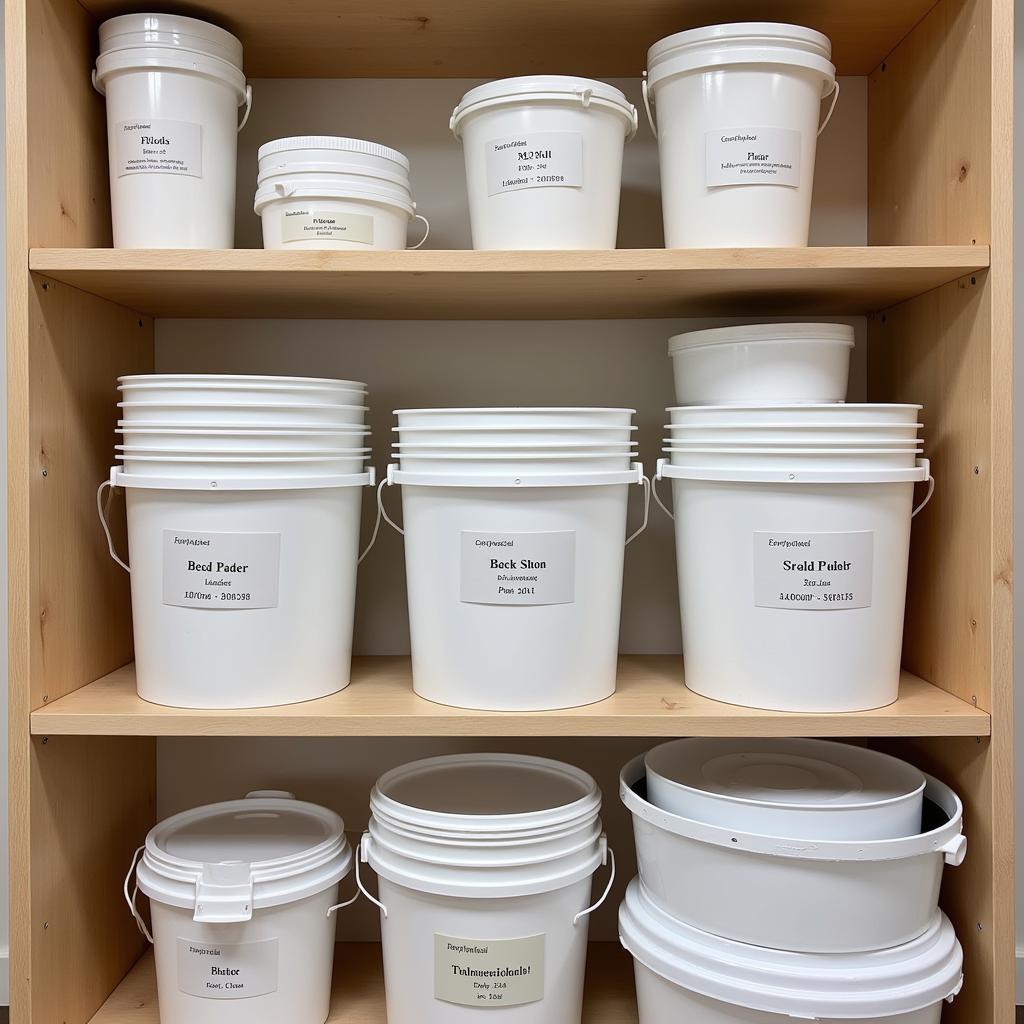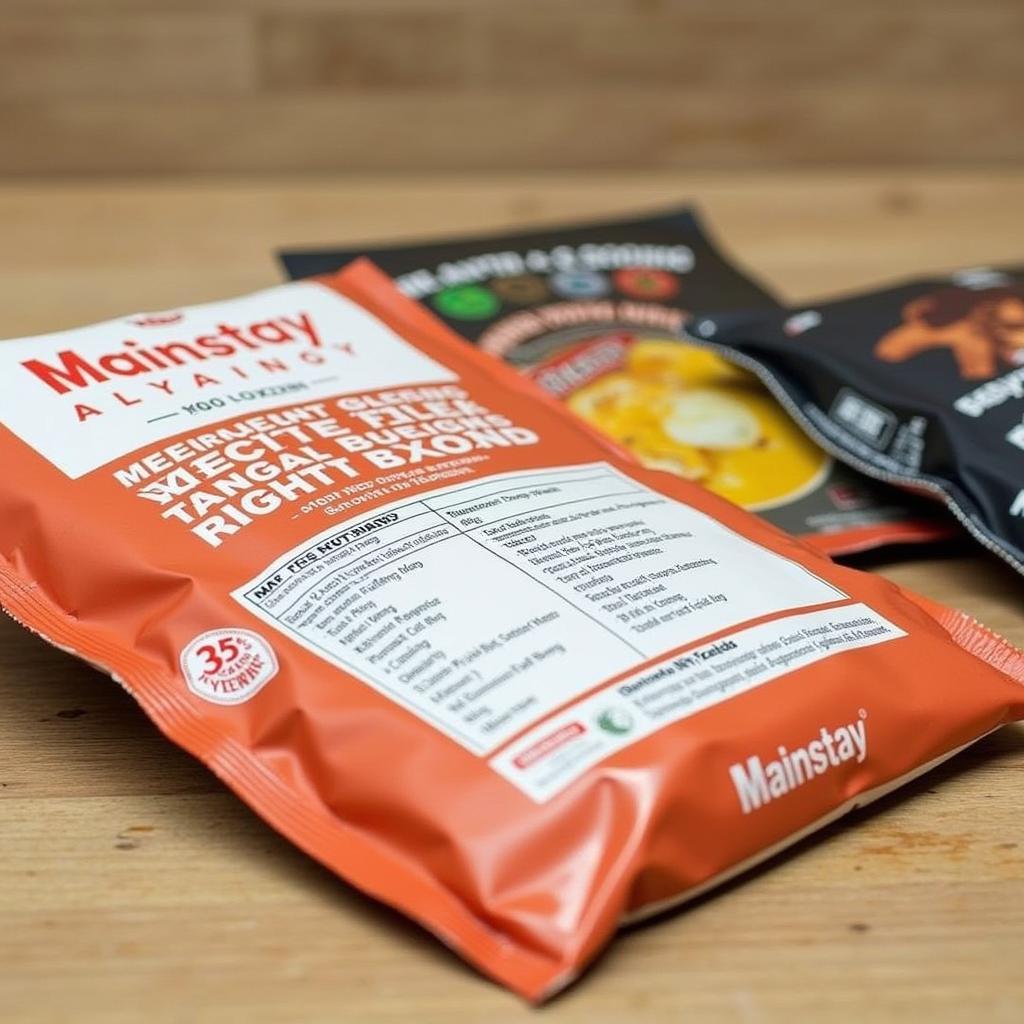Navigating the world of Food Bucket Survival can feel like exploring a pantry in the dark. What to stock, how to store it, and will it still taste good when you need it most? These are valid concerns, and that’s where we come in. This comprehensive guide will equip you with the knowledge and resources you need to build a delicious and dependable food bucket survival plan.
Deciphering the What and Why of Food Bucket Survival
Food bucket survival, in essence, is the practice of building and maintaining a reserve of shelf-stable food to sustain you and your loved ones during emergencies. Imagine a natural disaster, a power outage, or any event that disrupts access to fresh food. Your food bucket becomes your lifeline, providing essential sustenance when grocery store shelves run bare.
Building Your Culinary Fortress: Choosing the Right Food Buckets
Selecting the appropriate food buckets is the cornerstone of a successful survival strategy. Here’s what to consider:
- Duration: Are you preparing for a 3-month disruption or a more long-term scenario like a 25-year emergency? Your timeline will drastically influence the volume and types of food you need.
- Dietary Needs: Food allergies, intolerances, and specific nutritional requirements are paramount. Your food bucket should not just provide calories but also nourish you effectively.
- Taste and Variety: Let’s face it, even in a crisis, no one wants to eat bland and boring food day after day. Prioritize items you genuinely enjoy and explore options that offer culinary diversity.
- Storage: Consider your available storage space and ensure your chosen food buckets are designed for long-term preservation in a cool, dry environment.
 Food Bucket Storage Ideas
Food Bucket Storage Ideas
Practical Planning: Stocking Your Food Bucket for Success
Now that you understand the “why” and the “what,” let’s dive into the “how.” Here’s a breakdown of essential food categories to include:
1. The Energy Champions: Carbohydrates
Carbohydrates are your body’s primary energy source. Opt for complex carbs like:
- Rice: A versatile staple that can be incorporated into countless meals.
- Pasta: Provides a hearty base for soups, stews, and one-pot meals.
- Oats: A nutritious breakfast option or an ingredient in baked goods.
- Dried Beans and Lentils: Excellent sources of protein and fiber, adding substance to soups and stews.
2. The Building Blocks: Protein
Protein is essential for muscle repair and overall health. Include these protein powerhouses:
- Canned Tuna, Salmon, and Chicken: Ready-to-eat protein sources that can be added to salads, sandwiches, or enjoyed on their own.
- Nuts and Seeds: Packed with healthy fats, protein, and essential nutrients.
- Peanut or Almond Butter: Versatile spreads that can be enjoyed on crackers or used in recipes.
- Protein Bars: A convenient and portable source of protein and energy.
“When assembling your food bucket, prioritize nutrient density over calorie count alone,” advises Sarah Williams, a certified nutritionist and emergency preparedness specialist. “Think about sustaining your body’s overall function, not just filling your stomach.”
3. Essential Vitamins and Minerals: Fruits and Vegetables
Maintain a balanced diet even in emergencies by including:
- Canned Fruits: Choose options canned in water or their own juice for a healthier alternative.
- Canned Vegetables: Offer a range of nutrients and can be added to various dishes.
- Dried Fruits: A concentrated source of energy and nutrients, perfect for snacking.
- Freeze-Dried Fruits and Vegetables: Retain their nutritional value and flavor for an extended period.
4. Flavor Enhancers: Spices and Condiments
Don’t underestimate the power of flavor! Include a variety of spices and condiments to make your meals more enjoyable. Salt, pepper, garlic powder, onion powder, and Italian seasoning are excellent starting points.
5. The Hydration Heroes: Water and Beverages
Water is non-negotiable. Aim for one gallon of water per person, per day. Additionally, consider:
- Powdered Milk: Can be reconstituted with water for a source of calcium and vitamin D.
- Powdered Juice Mixes: Offer a flavor alternative to plain water.
- Instant Coffee or Tea: For a comforting and familiar beverage.
A 25-Year Food Survival Solution: Mainstay Emergency Food Rations
For those seeking a long-term solution, 25-year survival food like Mainstay emergency food rations offer peace of mind. These rations are specifically engineered for longevity and provide a balanced source of essential nutrients.
 Mainstay Emergency Food Rations
Mainstay Emergency Food Rations
Beyond the Basics: Additional Supplies for Food Bucket Success
To ensure you’re fully equipped, consider these supplementary items:
- Manual Can Opener: Essential for accessing canned goods.
- Camp Stove and Fuel: For boiling water and preparing hot meals when electricity is unavailable.
- Water Filter or Purification Tablets: To ensure access to safe drinking water.
- First-Aid Kit: For addressing any minor injuries or ailments.
- Multi-Tool: A versatile tool that can be useful in various situations.
Staying Prepared: Maintaining Your Food Bucket
Building your food bucket is an accomplishment, but the journey doesn’t end there. Implement these strategies for long-term preparedness:
- Regular Inspection: Check your food bucket every six months for any signs of spoilage or damage.
- Rotation: Practice the “first in, first out” method by consuming older items before their expiration dates and replenishing your stock.
- Proper Storage: Store your food bucket in a cool, dry, and dark location to preserve its freshness and extend its shelf life.
Food Bucket Survival: It’s More Than Just Food, It’s Peace of Mind
Building a food bucket survival plan is a proactive step toward ensuring your safety and well-being during unexpected events. By investing the time and effort now, you can face the future with confidence, knowing that you have a reliable source of nourishment to sustain you through challenging times. Remember, preparing for the unexpected doesn’t have to be daunting. With a well-stocked 3-month food survival kit or a comprehensive long-term strategy, you’ll be ready to weather any storm, one delicious bite at a time.
Food Bucket Survival: Frequently Asked Questions
1. How much food should I store in my food bucket?
The amount of food you store depends on your individual needs and the duration you are preparing for. A general guideline is to have at least a two-week supply of food per person, but ideally, aim for a longer period, such as three months or more.
2. What are some compact and calorie-dense foods for a food bucket?
Consider options like peanut butter, trail mix, protein bars, dried fruits, and nuts. These items are packed with nutrients and can provide sustained energy in a compact form.
3. Can I store Mainstay emergency food rations alongside my regular food bucket items?
Absolutely! Combining long-shelf-life rations with a diverse range of food items from your regular food bucket can provide both variety and extended peace of mind.
4. What is the best way to rotate the food in my survival bucket?
Implement the “first in, first out” method. Label your food items with their purchase or packaging dates and consume the oldest items first, replacing them with newer stock.
5. Where is the ideal place to store my food bucket?
Choose a cool, dry, and dark location to preserve the quality of your food. Avoid areas with extreme temperature fluctuations or exposure to direct sunlight.
Need More Support with Your Food Bucket Survival Plan?
Contact our team at Mina Cones Food today! We’re here to assist you with building a comprehensive food bucket that meets your specific needs and provides peace of mind for the future.
Call: 02437655121
Email: minacones@gmail.com
Visit Us: 3PGH+8R9, ĐT70A, thôn Trung, Bắc Từ Liêm, Hà Nội, Việt Nam.